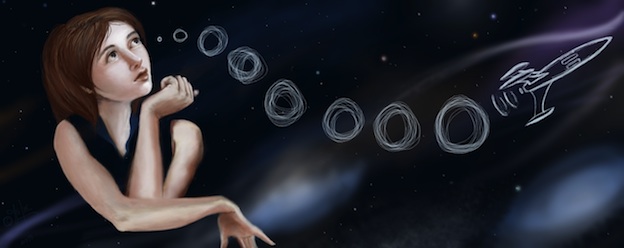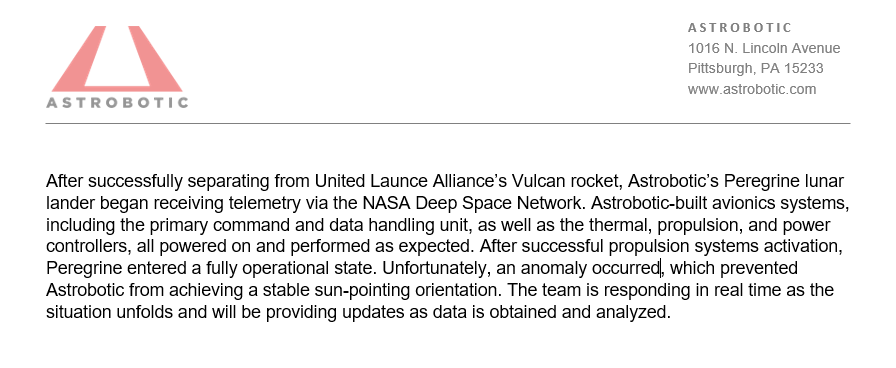“Spies in the skies” wasn’t actually the title of the talk given by HEO’s Toby Harris and Hannah Dawe at the Royal Aeronautical Society this week, but it was all I could think about afterwards.
HEO’s stated goal is to “image anything in the solar system, on demand” (though on further questioning it became clear this was more ‘catchy tagline’ than serious intention to image gas giants).
Their service offers customers the chance to get images of objects in space using existing space assets, such as Earth observation satellites. These images can help customers identify issues with the space hardware, characterise space debris for better debris-removal mission design, calculate tumble rates ahead of re-entry, or, of course, check out what another country has just launched.
How does it work?
HEO has access to around 35 EO satellites that can be used to capture images of items in space when the target objects cross their path. As space gets more congested, space situational awareness is increasingly important. Objects in space are meticulously tracked so that collision avoidance manoeuvres can be taken if two objects get a bit too close for comfort. HEO makes use of this tracking data to work out when a target object will (at a safe distance) cross the path of an EO satellite in its network. When it does, they can task the EO satellite to point in the target’s direction, image it, and send back images for their customers.
It’s not quite as simple as taking a snap any time an object is close enough. HEO’s customer needs are not the prime mission of the EO satellites, so images need to be taken in their ‘down-time’. You also have to consider the angle of the Sun to ensure that your target is well lit for the best picture. (It can sometimes be useful to get a silhouette of an object as this could give you information about its attitude ahead of re-entry, for example, but in general they want objects to be reflecting sunlight.)
Customers request images of an object, and HEO checks for suitable conjunctions. Depending on conjunction timing, angle of the Sun, and distance, they select the best satellite and task it to take photos. It usually takes between 24-72 hours to find a suitable conjunction and images are with the customer within 24 hours of them being downlinked.
Non-Earth Imaging (NEI)
The company originally wanted to image near-Earth objects to learn more about them and characterise them for mining, but as Toby, HEO Director of Space Applications, admitted, both the imaging and mining ideas turned out to be hard.
The space-to-space imaging they now offer is focussed on delivering non-Earth imaging (NEI) of objects such as satellites, rocket bodies, and space stations. Analysis is carried out to determine size, geometry and configuration, and also help to determine the object’s intended use. The company can also construct 3D models of objects based on captured images and available open-source data.
By taking multiple images of the Chinese space station Tiangong, while it was being built for example, HEO was able to build up a 3D model showing how different modules were brought together during station construction.
Dual use
Not only does the HEO approach create a dual purpose for existing satellites, it can also be used for both civil and military purposes. On the civil side, it could help satellite operators check the status of their hardware, check for debris after deployment, predict re-entry locations or to de-risk active debris removal – all things that Toby and Hannah were keen to highlight. But the military applications are hard to ignore.
With visible and multispectral sensors, NEIs could help military agencies and governments get a close-up look at what competitors have put in space – gauging the form, function and physical make-up of their assets. Inevitably military space assets from countries like the US will have already had this capability, but HEO claims to be offering the world’s first commercial in-orbit satellite inspection software programme – and anyone can sign up for an account.
This raises some questions. As a commercial company, how does HEO balance the need for commercial income, with security concerns from competing national customers? Hypothetically, if Russia wished to buy images of US assets, and money wasn’t an issue, would HEO fulfil the request? Toby’s response was that if they did, they’d not get much business from the US again. That makes sense, but what about less clear-cut situations?
And what of the satellite owners and operators? Do they know who the end customer is? Can they opt out of military requests? This is probably less of an issue for commercial satellites, but if HEO wants to grow its network and coverage, it could be a blocker to using satellites owned by civil space programmes.
Insurance
I was also keen to know where liability would lie if an EO satellite was damaged in the course of taking an image for an HEO customer. If the satellite was turned to face a target object and a sensor got frazzled by the Sun for example, would HEO be liable for the loss? Are they insured? (On that point Toby wasn’t 100% clear – but pointed out that while they make the task requests, they are never operating the EO satellite themselves.)
On the flip-side, could space-to-space imaging be used to determine liability in the case of an accident in space? Or to check that space players are meeting their obligations to reduce space debris?
Future goals
HEO has developed its own sensor payloads – Holmes and Adler – that can be launched on 3rd party satellites. Holmes 1 and 2 have already been launched, and the company aims to increase its available coverage.
Currently they can image objects up to 800km altitude, and cover two-thirds of LEO, with full coverage planned by 2025. Objects in High LEO and GEO are visually unmonitored, but HEO is planning missions to allow imaging in these orbits in 2025.
HEO services could be a huge help for active debris removal missions. Being able to check the state and shape of the object you want to de-orbit, as well as its tumble rate, would help de-risk missions.
HEO was used to image the European Remote Sensing 2 (ERS-2) satellite during its recent re-entry. It is hoped that combining in-space images with data from ground-based sensors could lead to more accurate re-entry predictions in future.
The use of existing space assets has allowed HEO to develop a product without taking on the risk and cost of launching its own network of satellites. It’s smart to use EO satellites when they are not taking images for their primary mission and helps us to get the maximum benefit of satellites without further adding to the congestion of space.
Whatever the customers’ reason for using the service – inspecting faulty satellites, characterising space debris, predicting re-entry profiles or spying on your competitors – securing access to a network of EO satellites to deliver it is impressive.
News by .
I often hear hiring managers complaining that there aren’t enough software developers, or people with the skillsets they are looking for, and this is certainly the case in the space sector.
The UK Space Agency has now launched some new funding for training programmes they hope will address the needs of the sector and encourage more people into the industry.
The recently announced Training Programmes Fund has a pot of £1.8m to fund courses and training with the aim of removing barriers to the growth of the UK space sector. But interested parties will have to act fast – the deadline for applications is only a month away, at 5pm on 29th March (Good Friday!).
According to Peter Trussell, Future Workforce Lead at the UKSA, the Agency is looking to fund new training courses that address the skills needs of the industry and which have an “identified and evidenced” customer base. The courses need to be accessible, easy-to-update, and meet industry standards, as well as be self-sustaining once funding is withdrawn. The UKSA is underwriting the development and delivery of courses that must be free to access during the course of the grant in an attempt to catalyse new training initiatives.
Among the challenges the UK space industry faces is the shortage of electronics, software and systems engineering skills, and the difficulty recruiting to these roles due to high competition. 45% of companies reported difficulties keeping staff due to poaching (from within and outside the sector) and low pay, and 83% have faced problems hiring from abroad. (Data from the Space Sector Skills Report 2023.)
Lack of diversity is also an area the industry needs to address. Women are currently just 23.7% of the UK space workforce (Size and Health of UK Space Industry 2022).
Applications for funding from the Training Programmes Fund can target existing space industry employees, career changers, students and early-careers programmes, people in unemployment, disadvantaged or underserved people, and those from a diverse range of backgrounds. Indeed, potential applicants were reminded that diversity is important to the UKSA and encouraged to make it clear if their proposals would improve diversity.
In terms of timing, the deadline for applications is 29th March, with panel reviews beginning as soon as April 1st. They hope to begin due diligence work on 8th April, notify successful applicants in the week commencing 22nd April, so work on programmes can begin the following week. The only catch is that the grant period ends on 21st March 2025, meaning that all development, recruitment, delivery and evaluation of these new training programmes must be complete by that date.
It’s a big ask – and one wonders if by attempting to do so much in so little time, the potential impact of the scheme might be hampered – but it’s a positive sign that the Agency is putting its money where its mouth is to support the UK’s growing space sector.
If you’re in the space sector, with a skills-gap that you need help filling, or perhaps you’re a training company who’d like to partner with space experts to develop a bid for funding, take a look at the advice for applicants. I’m available on a freelance basis if you need support making connections, researching, writing, or sense-checking bids. Let’s make it happen!
News by .
Astrobotic is an American commercial space company with its headquarters in Pittsburgh. It was originally formed to compete in the Google Lunar X-Prize (GLXP) – an international competition to send a commercial lander to the Moon, land, deploy a rover that could drive 500m and send high-quality video back from the Moon. The competition officially ended in 2018 with no team successfully winning the prize money, but Israel’s SpaceIL and Japan’s Team Hakuto went on to attempt lunar landings, sadly without success. Although no-one won the GLXP, it boosted the commercial industry and led to NASA’s Commercial Lunar Payload Services (CLPS) programme. Astrobotic is the first company to launch under the CLPS programme and hoped to deliver NASA scientific payloads to the Moon.
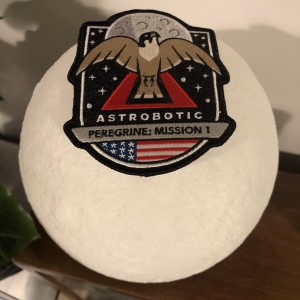
Peregrine Mission 1 patch
What was Peregrine Mission 1?
PM-1 was the first attempt by an American private space company to land a spacecraft on the Moon. At the time the mission launched, only four countries – the US, Soviet Union (as was), China and India had successfully managed a soft landing on the Moon.
The mission was carrying payloads from 16 customers from seven nations, and included five CLPS payloads, and an additional experiment from NASA. The mission launched on 8th January, 2024, and was due to land on the Moon on 23rd February.
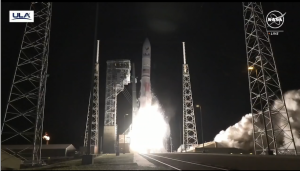
Vulcan launches Peregrine Mission 1
What happened?
After a smooth launch on ULA’s Vulcan rocket, the Astrobotic team conducted spacecraft checkout procedures, and then discovered an anomaly. The rest of the day was a total rollercoaster for anyone following the mission.
An issue with a valve on one of the fuel tanks led to the tank being breached and they were losing fuel. In addition, the spacecraft was not pointing in the right direction for the solar panels to be charged by the Sun. The team attempted to reorient the spacecraft and managed to recharge the internal batteries and extend the life of the spacecraft.
Over the next few days, the team managed to eke out additional mission time, and activate the payloads with an electrical connection to the lander so that they could be tested, and data collected. As the propellant leaked out, pressure in the tank reduced and the leak slowed, allowing them to further extend the life of the lander.
The spacecraft reached lunar distance, but at a point in time when the Moon was not at that position. The mission trajectory had them returning to Earth before rendezvousing with the Moon two weeks later. As the spacecraft returned to Earth, there was a chance that they might have had enough propellant to conduct a swing-by and return to lunar distance to attempt a lunar collision, but after much discussion, the company decided the responsible thing would be to allow the craft to burn-up in Earth’s atmosphere, rather than risk creating space debris in cis-lunar space.
This must have been a really tough decision for a team that had been working for 16 years to make this mission a reality, but Astrobotic proved themselves to be a class act with their regular, clear and transparent mission updates, and this difficult, but admirable decision.
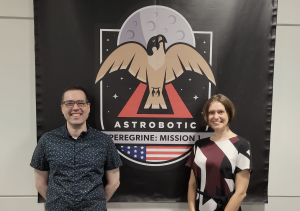
Kate and Nate in Peregrine Mission Control, 2022
So the mission failed, that’s bad isn’t it?
While the mission didn’t successfully land on the lunar surface, to write it off as a complete failure would be unfair. To get a spacecraft into space, manage to operate it despite a fuel leak, operate payloads and receive data is all still very impressive, especially for a first try by a commercial company. They will have learned a lot from this mission and that will feed into the company’s next mission attempt, due later this year.
Landing on the Moon is hard, and over the past few years there have been numerous failures. In 2019 Israel’s Beresheet mission failed to soft-land, as did India’s Chandraayan-2. In 2022 Japanese company i-space’s Hakuto-R Mission 1 failed, and in 2023 Russia’s Luna 25 “ceased to exist after a collision with the lunar surface”, as reported in their press release. China’s lunar programme has multiple successes, including the first landing on the far side of the Moon with Chang’e 4 in 2018, and a sample return mission Chang’e 5 in 2020. India joined the ‘lunar landing club’ in 2023, with Chandraayan-3 successfully landing on the Moon. On 19th/20th January 2024 (depending on your time zone) Japan’s SLIM spacecraft soft landed on the Moon, making them the fifth nation ever to do so.
What does this mean for NASA?
Although there were several NASA payloads on this mission, it’s important to remember that this wasn’t a NASA mission, rather NASA was a passenger on Astrobotic’s mission. It’s not just a matter of semantics, and here’s why.
The CLPS programme, whereby NASA pays commercial companies to deliver their payloads to the Moon, is designed to both boost the commercial space industry and encourage multiple competing companies to develop technology, and also to help reduce costs for NASA. If NASA were to design, develop, build and operate a mission, it would be more costly, and they would be taking on the entire risk of the project. By paying for commercial companies to provide these services (much like they do for cargo delivery and crew transport to the ISS) they can focus their resources on other areas of science and exploration. With the reduced costs, they are also able to accept a higher level of risk, and at the time the first CLPS contracts were given out, Dr Thomas Zurbuchen, who was NASA’s Associate Administrator for the Science Mission Directorate at the time, said they were prepared for around 50% of the initial missions not to work. This is *very* different to the level of risk they would tolerate on a normal mission, and allows NASA to take advantage of different companies testing and refining their technology.
But NASA has delayed it’s crewed Artemis flights, hasn’t it?
Yes. NASA announced on January 9th, the day after Peregrine launched and the anomaly was discovered, that it was delaying its crewed mission around the Moon (Artemis II), from no earlier than (NET) November 2023, to September 2024, and the lunar landing flight, Artemis III, until NET September 2026.
I was asked in a radio interview if this was due to the Astrobotic failure, but I believe this was just unfortunate timing for Astrobotic! The success or failure of their mission shouldn’t have had any impact on the Artemis schedule.
The decision to delay was made for a variety of reasons, including the need for further research on the thermal protection system, an issue with a circuit on Orion that needs correcting, and progress of external partners.
When they announced the delays, NASA was very keen to stress that crew safety was always their number one priority. They will fly when they are ready.
What was onboard Peregrine?
Peregrine was carrying a range of scientific and non-scientific payloads for customers from seven countries.
The CLPS payloads for NASA were:
- a laser retro reflector array acting as a location marker attached to the lander
- a neutron spectrometer to study regolith at the landing site and measure the presence of hydrogen
- a linear energy transfer spectrometer, to learn about the radiation environment, like the one sent on Exploration Mission I (EM-1) to gain information about the radiation that astronauts might be subjected to during Artemis missions
- a near infra-red mass spectrometer – to measure surface and sub-surface hydrations, look for water, hydroxyl, carbon dioxide and methane molecules, as well as mapping the surface temperature and morphology
- an ion trap mass spectrometer – designed to characterise the Moon’s exosphere after descent and landing. Taking observations of the outermost bit of atmosphere would enable an understanding of what volatiles were kicked up during landing. (NASA, ESA and the Open University partnered on this instrument)
An additional NASA payload was the navigation doppler Lidar, to precise velocity tracking and range sensing.
Carnegie-Mellon University sent up a student-built ‘nano’ lunar rover, with a mass of approximately 1.8 kg (4lbs). It was designed to work for around 50 hours on the lunar surface.
Astrobotic wanted to test their terrain relative navigation sensor, to allow more accurate landings on the Moon – and other locations in future.
An additional scientific payload came from Mexico, with their COLMENA project, which looked to test incredibly small robots (12 cm, <60 g) to see if the five robots could self-organise on the lunar surface. They are designing these with a view to future exploration and mining.
German Space Agency DLR sent up the M-42 radiation detector, again hoping to learn more about radiation and feed into the Artemis programme.
Non-scientific payloads
From Japan, Astroscale’s Pocari Sweat lunar dream capsule sent the messages from tens of thousands of children around the world into space. This payload was clearly visible in some of the images that Astrobotic managed to capture during their mission.
From The Seychelles, a unique physical Bitcoin, loaded with one bitcoin was sent.
On the Bitcoin theme, US Bitcoin Magazine sent a copy of the ‘genesis block’ – the first block of bitcoin to be mined. UK company SpaceBit sent a SpaceBit plaque (though originally they had talked about sending a small rover).
Also from the US customers were the MoonArk payload “a set of intricately designed objects to spark wonderment” and represent arts, humanities and sciences, The Arch Library, a long-term archive being sent to different planets and the Moon, and two space memorial flight services payloads. Some of the Celestis payload was sent into a Sun synchronous orbit by the Vulcan rocket, and both Elysium and Celestis offer to inter remains on the lunar surface. This sparked some controversy with the Navajo Nation calling for discussion about whether human remains should be allowed to be sent to the Moon, which they regard as sacred.
The Hungarian payload ‘Memory of Mankind* on the Moon’ was a plaque with archive text and images that could be magnified and read.
Last but not least – the DHL MoonBox – from Germany, allowed people to buy capsules and send mementoes and keepsakes to the Moon. Certainly more exciting than your usual parcel tracking, but sadly the items were ultimately ‘lost in the post’ – or more technically, burned up in Earth’s atmosphere. Still, they gave members of the public the opportunity to put something of theirs in space, and that’s a whole new level of access.
*I prefer and promote usage of more inclusive terms such as humanity, but this was the actual listed name of the payload
So, what’s next?
Just a day after Astrobotic’s mission came to a fire-y end, Japan’s SLIM mission successfully landed on the Moon, making them the fifth nation to do so.
Another US company with a CLPS contract, Intuitive Machines, is set to launch its first mission to the Moon in early 2024. They hope to land at Malapert A near the South Pole and will be carrying five NASA CLPS payloads as well as commercial cargo. They hoped to launch between 12th-16th January, but scheduling delays pushed the launch to NET February. Had Astrobotic not had its fuel leak, there was a chance that both PM-1 and IM-1 would have attempted their lunar landings within a matter of days, as Intuitive Machines have opted for a faster route from Earth to the Moon.
The next Astrobotic launch is due in November 2024, and will see its Griffin lander attempt to land at on the lunar surface, delivering NASA’s Volatiles Investigating Polar Exploration Rover (VIPER) to the south pole of the Moon to search for water ice and other resources.
News by .
What an exciting start to 2024 we’ve had! The maiden flight of ULA’s Vulcan-Centaur rocket, an American commercial company launching its first mission, delays to the Artemis programme, a commercial crew heading to the space station, and now Japan has become the fifth nation to soft-land on the Moon. It’s a lot to get your head around, so I’m going to break it down into a few handy guides to tell you everything you need to know.
Let’s start this little series of summaries with Vulcan Cert-1…
What is it?
Vulcan-Centaur is the new rocket from the United Launch Alliance (ULA), a company formed in 2006 from the partnership of Boeing and Lockheed Martin. This is the first rocket they have built since forming ULA and is important for the company’s ability to compete with SpaceX.
The Vulcan-Centaur rocket can fly in various configurations depending on customer needs, with up to six solid rocket boosters (attached in pairs), to give it extra thrust capacity, and launch larger payloads than their Atlas V rocket. The two BE-4 engines on the first stage were developed with Blue Origin and will also be used on their heavy lift New Glenn rocket, due to launch later this year.
Why was this launch important?
There have been rumours that ULA is looking for a buyer, and with SpaceX now able to compete for, and win, military launch contracts, the heat is on. Despite maintaining a 100% launch success rate, if you compare the launch rate of SpaceX and ULA in 2023, you can see that ULA really couldn’t afford for anything to go wrong with this mission. SpaceX managed 98 launches in 2023, compared to just three from ULA. Long gone are the days when ULA was the only option for national security launches.
Vulcan was hit by delays, and there were some test failures which resulted in the first launch slipping from the initially hoped for 2019, to January 2024.
The BE-4 engines are also important. Previously ULA has used Russian-made RD-180 engines, and there has been a push to switch to using American-built engines for supply, security and political reasons.
What was the payload?
The main payload on the CERT-1 mission was Astrobotic’s Peregrine Mission 1 lunar lander (more on that later), with a secondary payload from Celestis – a memorial spaceflight company. Accepting the risk of flying on a never-before-flown rocket kept the launch costs down for Astrobotic on their maiden flight.
Was the CERT-1 flight a success?
The Vulcan-Centaur launch went incredibly smoothly and ULA CEO, the characterful Tory Bruno, let out a “yee haw” as the rocket made it through launch, MaxQ, booster separation, fairing separation, and Centaur ignition without issue. It delivered Peregrine to approximately 500 km altitude, where it separated, before firing its engine for a third and final time, taking the Celestis memorial payload into a sun synchronous orbit, where small pods containing ashes, DNA, and messages will remain forever.
News by .
